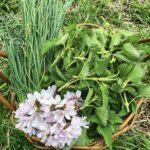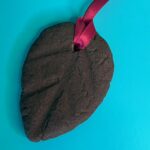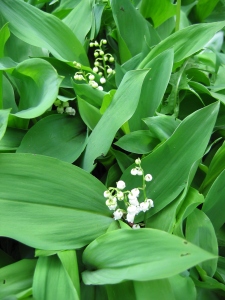
Lily of the Valley in flower
This has to be one of the most beautiful medicinal plants in the UK. Its as rare as hens teeth in the wild, mostly found in gardens nowadays but I am so lucky to have stumbled accross a large patch of it in a nearby deciduous woodland. Ambling along a deer track with my dog one Spring morning a good few years ago, it stopped me dead in my tracks as the verdant green leaves and snow white bells sang out from the darkness of the woodland floor. And the aroma, no words can describe ! My heart fluttered with delight as I realised what I was looking at. Lily of the Valley (Convallaria majalis) has been a firm favourite of mine since early childhood, a dear old friend of the family had it growing all around an old apple tree in her tiny terraced house garden and for me it was love at first sight. I have since tried to get a colony established in every garden I have lived in, knowing now that they really do prefer to grow at the roots of trees – finally I have a rapidly expanding patch below the roots of a very tall holly and hazel hedge.
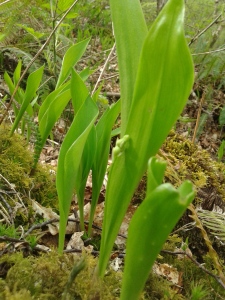
Lily of the Valley on the woodland floor
Later in life, I learned that the effect it had on my emotional heart (uplifting and joyous) was also echoed in its medicinal properties … it is a prime heart tonic used in cases of congestive heart failure, when the heart struggles to pump the blood with any proper force around the body *. The flowers also benefit a heart that is weak, irritable and beats irregularly, slowing yet strengthening the heart beat and force. It also acts as a diuretic, ridding the body of excess fluids which often accumulates in the tissues in heart weakness. Unlike most other diuretics, Lily of the Valley does not lead to a depletion of potassium. Its also a very serious contender for valvular disorders of the heart and will also reduce blood pressure as a result of its diuretic and heart strengthening actions. Useful for chronic palpitations and tachycardia. Encourages the restoration of deep regular rythmic breathing.
It has really fallen out of use today but has been in use as a ‘folk’ medicine for centuries (first documented in the 4th century) for problems such as vertigo, nervous irritability, convulsions, as a brain tonic to improve cognitive function and memory, cleans the lymphatic system and of course for its healing action on the entire heart itself and its ability to reduce blood pressure. It has been used successfully in patients recovering from strokes, particularly when speech is slow to return.
The flowers are the parts to be used therapeutically and can be made into a simple tea or infused into white wine. They can also be made in syrups and also distilled and used for face washes to rid of blemishes. The dried flowers can be powdered and used as a snuff up the nostrils to clear the ear, nose and throat passages of accumulated mucous – thereby helping with headaches and symptoms relating to congestion.
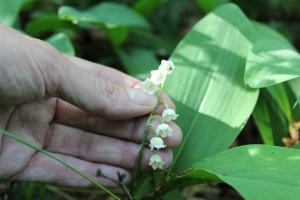
Lily of the Valley flower spikes
The old folk remedy dose for Lily of the Valley tea is 10g of fresh flowers (some snip the whole flowering stalk and use this, others just the flowers) infused in 1 pint of boiling water. Infuse for 20 minutes, strain and take 1-2 tablespoons up to 3 times daily, maximum of 4 tablespoons daily. Store the ‘tea’ in the fridge for up to 3 few days.
One of my favourite folk herbalists, Juliette de Bairacli Levy, describes it as a “heart tonic & remedy, not habit forming. Very calming to the heart, as well as healing. Treatment of nervous ailments including epilepsy, fits, hysteria. Cures dizziness, clears the mind & strengthens memory, soothes nervous irritability. Reduces high blood pressure, reduces risk of apoplexy (bursting of a structure within the brain). For dropsy and all lymph irregularities. Treatment of infestation by thread and round worms, inflamed bowels. Extrenally the leaves cool all forms of inflammation”.
Her suggested dose is to take 2 handfuls of the flower spikes in 1.5 pints of water. One small wineglassful morning and night.
Another herbal from the 1970’s (Grandmothers Secrets by Jean Palaiseul) suggests using 1-2 g of dried flowers to 100ml of boiling water, infuse for 5 minutes, one cup daily between meals.
The dose for a tincture is 0.5-1 ml 3 x daily for a 1:5 tincture or 0.3-1.2ml 3x daily for a 1:8 tincture.
As you may have gathered by now, Lily of the valley is a powerful medicine and since the arrival of more modern pharmaceutical drugs has fallen out of use as a herbal remedy. She is a powerful force for sure but should not be feared, just respected and used with caution and wisdom. She is an incredible plant ally to get to know – her gifts (like every plant) are far more than just physical. She called me to her all those years ago and I have been deeply in love with her ever since.
Just to be crystal clear…….
*Avoid completely if you have serious heart issues and are taking prescribed medications of any kind.
* Use with caution due to the action on the heart, preferably under the guidance of an experienced herbalist, but also bear in mind that she has been used by folk as a home remedy for many centuries, just be respectful and wise using her powerful gifts !
* It contains many constituents that have a therapeutic action on the heart, similar to Foxglove but less dangerous as it doesn’t accumulate within the body. If you encounter any unpleasant or unusual side effcets, stop taking immediately.
